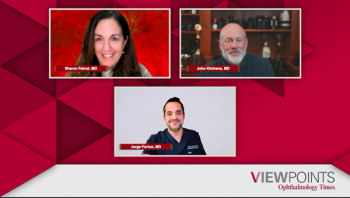
Q&A: William F. Wiley, MD, on what BVI's trifocal IOL approval means for US premium vision options
As a US clinical investigator, Wiley shares his insights on the FineVision HP trifocal lens, highlighting patient visual outcomes, satisfaction, and its impact on cataract surgery practice.
As the landscape of ophthalmic innovation continues to evolve, new technologies are reshaping how vision correction is approached in clinical practice. One such advancement is the recent FDA approval of a novel trifocal intraocular lens (IOL) (FineVision HP; BVI) that expands the selection of premium lens solutions accessible to US ophthalmologists and their patients.1-3 This milestone represents the debut of a lens in the US that has already seen widespread global use in millions of surgeries, according to the company.1-2 It also reflects the company’s strategic initiative to grow its premium IOL offerings within the US health care landscape.1-2
To explore the implications of this latest approval and what it means for US surgeons and their patients, the Eye Care Network sat down with William F. Wiley, MD, medical director of the Cleveland Eye Clinic, and assistant clinical professor of ophthalmology with University Hospitals, Case Western University, in Cleveland, Ohio.
Note: Transcript edited for clarity and length.
From your experience as a US study investigator, please share your insights on this trifocal lens’ performance in terms of patient visual outcomes and satisfaction. Are there key differentiators to highlight for US surgeons?
Our study experience with [this trifocal lens] was extremely positive. Once we implanted the first few lenses and saw how happy patients were, enrollment became effortless—we knew the outcomes would be strong. Patients consistently reported excellent visual quality and satisfaction, with a full range of vision across near, intermediate, and distance.
One of the most impressive aspects was the balance between visual range and side-effect profile. Every multifocal lens requires that trade-off, but [this lens] navigates it exceptionally well—delivering class-leading vision with very few visual disturbances.
RELATED: FDA clears BVI’s FineVision HP trifocal IOL for the US market
A major differentiator is the lens platform itself. The 4-point fixation haptic design ensures excellent centration and long-term stability, which is crucial for both multifocal and toric performance. It provides surgeons confidence that the lens will stay exactly where it should, supporting consistent outcomes.
The learning curve was minimal—implantation was intuitive, and the injection system is very smooth. Finally, [this] is the only trifocal with a double-C design in the US, which sets it apart technologically and gives it a unique positioning in the premium IOL space.
What types of patients do you see benefiting most from this lens technology, and what considerations should surgeons keep in mind when recommending it?
[This lens] is ideal for patients who desire spectacle independence and want functional vision across all distances for everyday tasks. They should understand the advantages of trifocal technology—broad range of vision and reduced dependence on glasses—while also having realistic expectations about minor trade-offs such as potential night-vision effects.
Surgeons can feel confident that they are offering a lens that delivers on what patients expect: strong distance, intermediate, and near vision with minimal compromise. As with any trifocal, success comes from good patient selection and education, but this lens gives surgeons real confidence that they can achieve excellent outcomes consistently.
With millions of implantations worldwide, what lessons from international use of this technology were most valuable in shaping the US clinical trial outcomes?
The international experience with [this trifocal lens] gave us tremendous confidence going into the US study. We knew it already had a proven track record as a leading trifocal lens globally, which helped both investigators and patients feel assured about its performance.
That reputation accelerated enrollment and shaped our expectations—we weren’t introducing an untested concept but rather validating a technology that had established reliability and consistency in visual outcomes. The global data reinforced our belief that [the lens] would meet or exceed the standards set by existing premium lenses in the US.
How do you see FDA approval influencing the broader landscape of premium IOL options in the US, and what does it mean for the future of cataract surgery innovation?
[The FDA approval] represents a major step forward for premium IOLs in the US. It introduces a proven, innovative platform that broadens the options available to surgeons and patients.
Competition in the premium space is healthy—it drives improvement and raises the bar for performance and patient outcomes. Having [this lens] available gives surgeons another trusted, high-performing option to tailor vision correction to individual needs.
More broadly, this milestone signals continued momentum in cataract surgery innovation—new optical designs, refined materials, and improved platforms are pushing the field forward. Ultimately, that means better vision and higher satisfaction for patients, which is the goal we all share.
REFERENCES
Stevenson S. FDA clears BVI’s FineVision HP trifocal IOL for the US market. Ophthalmology Times. October 14, 2025. Accessed October 27, 2025.
https://www.ophthalmologytimes.com/view/fda-clears-bvi-s-finevision-hp-trifocal-iol-for-the-us-market BVI’s FINEVISION HP gains FDA approval, ushering in a new era of advanced trifocal IOLs for US patients. News release. BVI. October 14, 2025. Accessed October 14, 2025.
https://www.bvimedical.com/bvis-finevision-hp-gains-fda-approval-ushering-in-a-new-era-of-advanced-trifocal-iols-for-u-s-patients/ BVI unveils what’s next at AAO 2025. BVI. Accessed October 14, 2025.
https://www.bvimedical.com/aao2025/
Newsletter
Don’t miss out—get Ophthalmology Times updates on the latest clinical advancements and expert interviews, straight to your inbox.














































.png)


